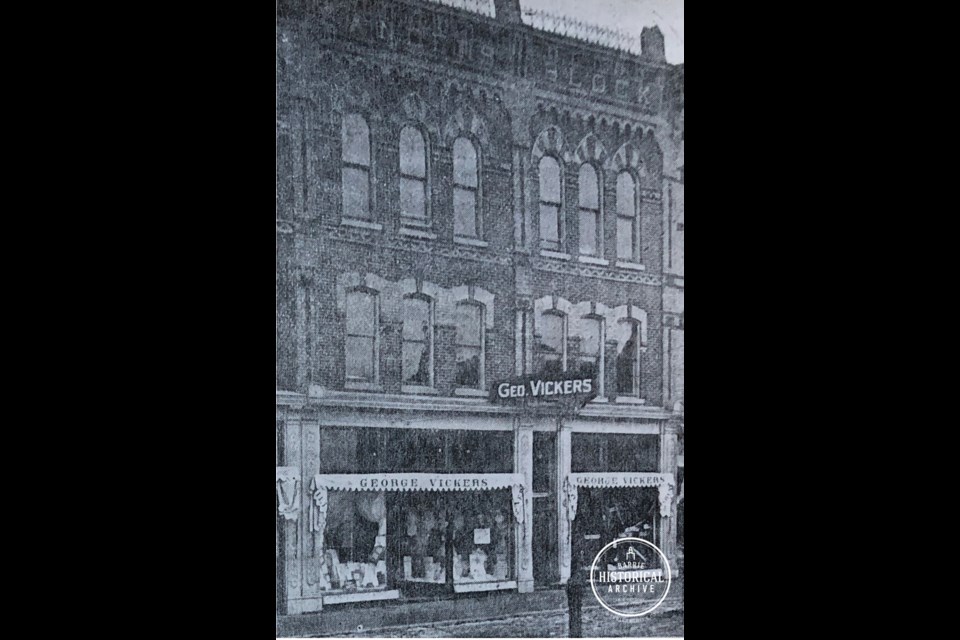This ongoing series from Barrie Historical Archive curator Deb Exel shows old photos from the collection and one from the present day, as well as the story behind them.
The George Vickers Store, 72-74 Dunlop St. E.
Many will recognize the landmark main street building that has been home to many businesses over the decades. It is the Sanders Block, designed and built in 1880 by Barrie architect Thomas Kennedy, for Leander Sanders, a jeweller.
The lovely building still retains so many notable features such as the metal finials on the roof and highly decorative brickwork, which includes the Sanders name built into the cornice. The Sanders Block is considered one of the best facades in Barrie and is designated under the Ontario Heritage Act for its architectural and historical significance.
George Vickers was born at St. Leonard’s, Sussex, England, in 1870 and came to Canada with his family in 1874, settling in Barrie.
At the time when George Vickers occupied this address, the building was considered one of the finest, so showy on the outside with its double front and large display windows. Inside, the natural light from the tall windows across the front of the store, as well as gas and electrical illumination, only enhanced the artfully arranged displays throughout the store.
More than 40 clerks staffed the various departments located on three floors, which offered the best-quality imported materials for dress making, millinery and men’s furnishings. Yes, the Geo. Vickers store was quite impressive.
Brother James Vickers, in the early 1900s, was considered the exclusive merchant tailor of Barrie with customers from all over the county. He also had a well-appointed, modern shop on the south side of Dunlop Street and enjoyed a reputation as an expert cutter and fitter. His work, fabrics and designs made him both very successful and well known in the industry.
Barrie loved its royal connections.
The Duke and Duchess of Cornwall stopped in Barrie for three minutes on Oct. 10, 1901. When Edward VII died in 1910 and the Duke succeeded him, a most glorious Coronation Day celebration in Barrie, chaired by Hampton Jory, was arranged for June 22, 1911. It was complete with a mile-long parade, concerts, sporting events and performances in the Agricultural Park attended by about 9,000 people. The day was so spectacular and such a success for the town that many clamoured to make the celebration an annual event, but the lack of funding in 1912 was a showstopper.
But early in 1913, it was George Vickers who convinced Mayor Alexander Cowan that it was 60 years since Barrie became a municipality and that such an important milestone should be recognized. So, with a grant of $500, plus the guarantee of another $500, Barrie’s Diamond Jubilee was scheduled for June 30 to July 1, 1913.
The townspeople were most definitely on board with this new celebration and, in May, were invited to start decorating their homes in anticipation of the big event.
The 60th birthday of Barrie was filled with airshows, music, motorcycle races, a parade, military tattoo, a water carnival and many more activities. Trains and steamers brought thousands of people to Barrie – it was estimated that a crowd of about 25,000 (Barrie had a population of about 6,400 at the time) participated in the celebration that was proposed by George Vickers.
George Vickers announced his retirement as a merchant in 1920.
His greatest hobby, among other interests, was horticulture, with a specialty in gladioli, holding positions such as vice-president of the Canadian Gladiolus Society, past president of the Barrie Horticultural and Town Improvement Society as well as a director of the Barrie Agricultural Society.
In 1934, he was appointed the registrar of deeds for Simcoe County. Working right up until the end, he suffered a heart attack in 1938 after a day at the registry office. His funeral was held at his home at 131 Owen St., considered one of the prettiest in town thanks to Vickers’s lovely grounds and gardens.



